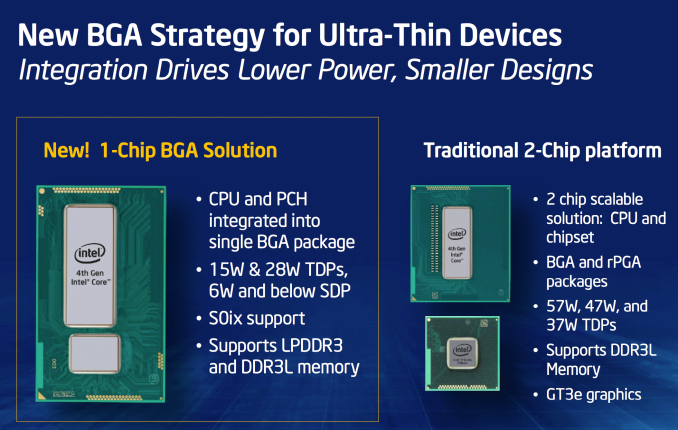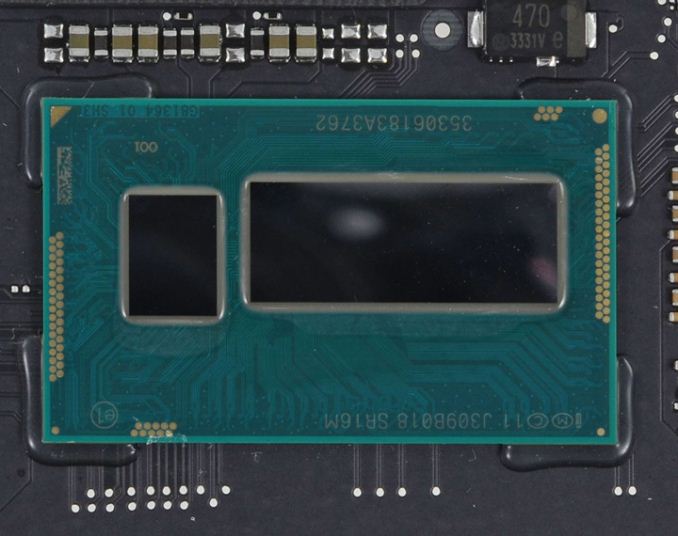The 2013 MacBook Air Review (13-inch)
by Anand Lal Shimpi on June 24, 2013 12:01 AM ESTThe CPUs
Apple keeps things simple across the 2013 MacBook Air lineup by configuring both 11 and 13-inch models with the same base CPU: a Core i5-4250U.
To understand Apple’s CPU choice, you have to understand that Apple is primarily concerned about improving battery life this generation. The line between MacBook Air and MacBook Pro has to be well defined. The Air is about portability, while the Pro is about performance. When faced with a power/performance tradeoff, it’s clear on which side of the fence Apple will fall whenever the MacBook Air is concerned.
| Apple 2013 MacBook Air CPU Comparison | |||||
| 1.3GHz dual-core | 1.7GHz dual-core | ||||
| Standard On | 11 & 13-inch MBA | Optional on Both | |||
| Intel Model | Core i5-4250U | Core i7-4650U | |||
| Base Clock Speed | 1.3GHz | 1.7GHz | |||
| Max SC Turbo | 2.6GHz | 3.3GHz | |||
| Max DC Turbo | 2.3GHz | 2.9GHz | |||
| L3 Cache | 3MB | 4MB | |||
| TSX-NI | No | Yes | |||
| TXT | No | Yes | |||
| AES-NI | Yes | Yes | |||
| VT-x/VT-x EPT | Yes | Yes | |||
| VT-d | Yes | Yes | |||
| TDP | 15W | 15W | |||
| Processor Graphics | Intel HD 5000 | Intel HD 5000 | |||
| GPU Clock (Base/Max) | 200/1000MHz | 200/1100MHz | |||
The lower base clock alone shouldn’t mean much, but the max TDP of the CPUs in the new MacBook Air falls as well - from 17W down to 15W. The thermal limit is even more dramatic since with Haswell ULT, the 15W includes the CPU/GPU as well as the on-package PCH. In Ivy Bridge the PCH was off package and wasn’t included in the 17W TDP.
Max turbo clocks are identical between the Haswell ULT CPUs Apple picked this round and the Ivy Bridge models before, but with a lower TDP it’ll be harder to always sustain the same frequencies given the right workload.
Haswell does feature a not insignificant gain in IPC compared to Ivy Bridge, which should help offset the power constraints that could otherwise force a larger regression in performance.
Both 2013 MBAs ship with the same CPU by default, and both can be upgraded to the same higher end SKU: a Core i7-4650U. The 4650U retains the same 15W TDP as the i5-4250U, but it increases its base clock speed to 1.7GHz and max turbo to 3.3GHz. The L3 cache also grows from 3MB to 4MB. All in all, this should be a very healthy upgrade in performance. Intel likely maintains the same TDP by binning for power; the i7-4650U is probably capable of running at higher frequencies without any appreciable increase in voltage. The max GPU clock also goes up by 10%.
Haswell ULT, Courtesy iFixit
What's arguably coolest about the i7-4650U is it enables Haswell's Transactional Synchronization Extensions (TSX-NI), a feature which is unfortunately disabled on the i5-4250U. I don't suspect this will matter much for most MBA users, but anyone looking to play around with Haswell's TSX instructions will want to opt for the higher end SKU. The upgrade costs $150 regardless of base model. Intel charges $454 for the i7-4650U and $342 for the i5-4250U, a difference of $112; Apple is adding another $38 onto the 1KU pricing, which isn't unreasonable.
Many have asked me what the impact of the i7 will be on battery life. I'm hoping to get my hands on an i7 based machine when I return from the UK in a week, but for those of you making immediate decisions I'll offer the following. Sustained operation at higher frequencies will likely draw more power, and negatively impact battery life. Light to medium workloads will enjoy a mix of race to sleep benefits as well as higher power consumption under load. Idle power should be roughly similar between the parts however. For most workloads I'd expect a modest impact to battery life, but it won't be enough to regress to 2012 levels of battery life. All of this is said without knowing key details like operating voltage for most 4650Us. I plan on addressing that shortly.












233 Comments
View All Comments
smilingcrow - Monday, June 24, 2013 - link
Says the person complaining about other peoples' immature posts.darwinosx - Monday, June 24, 2013 - link
Most projectors use HDMI, VGA is long dead. You could have taken two seconds to Google VGA adapter for MacBook Air to find there are many options though. Putting a VGA port an an Air would be idiotic. Actually on any modern laptop.SirPerro - Monday, June 24, 2013 - link
VGA is dead already. LAN... Well, I haven't tried a WiFi connection that comes even close to wired. And that's not going to happen in the near future.Apple doesn't look to the future. Apple looks to the wallet. And certainly charging some serious money for cable adaptors which everybody else includes for free is a very good move towards their target.
And yes, if they removed RJ-45 because it was too thick, they could've used a 50c adaptor to a phisical smaller interface. But that wouldn't be so profitable.
Kevin G - Monday, June 24, 2013 - link
There plenty of space to put in an RJ-45 jack into the Macbook Airs if Apple didn't care about ascetics: in the bezel of the LCD display. Part of the Cat5 cable would go through the the RJ-45 hole in the display. I'd only work with the screen open but for a wired connection it wouldn't be much of an issue I believe. The problem is that this is a pretty fugly solution.darwinosx - Monday, June 24, 2013 - link
Ah so you are a laptop engineer..no...an adapter is fine for those who need it.Kevin G - Monday, June 24, 2013 - link
An adapter is easily lost.... the display only gets lost with the rest of the computer.AirieFenix - Thursday, June 27, 2013 - link
Putting a RJ45 connector on the bezel of the screen... yeah, I prefer to not comment.Spoony - Monday, June 24, 2013 - link
I work for a large corporation too. I know that projectors are all VGA, and everybody uses PowerPoint to show awful ugly presentations with slides just repeating what they say with zero value-add. Anything we can do to exit this model has my full support, and not shipping ANY laptop with VGA would be a great start.Don't make excuses for lame prehistoric corporate IT, demand better.
lilo777 - Monday, June 24, 2013 - link
Yeah. Marketing spin in this review was stronger than usual. Here are some examples."To hit an aggressive schedule, you have to mitigate risk." Really? Since when Apple's schedule has become aggressive? Launching 5 products per year which in most cases have very little changes. It's not like the previous version of MBA was released three months ago.
"We’re talking about TN panels (admittedly higher quality than most) and traditional pixel densities. Compared to the Retina Displays deployed across the rest of Apple’s product lines, these panels just aren’t as good. Compared to what you typically find elsewhere, they’re still among the best." "Typically find elsewhere"? Are they trying to compare MBA with $400 laptops? If you look at the same price range (Sony Vaio Pro, Samsung 9 etc.) you will find much better displays than what MBA has. It looks like being an Apple customer Anand has developed an attachment to the brand that interferes with the quality of his reviews.
darwinosx - Monday, June 24, 2013 - link
Everything you said is wrong and ignorant but the dumbest is accusing Anandtech of bias.